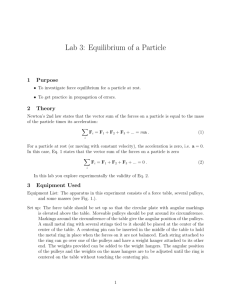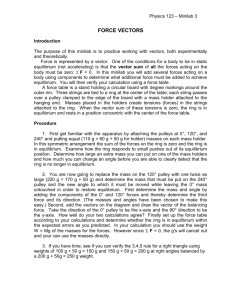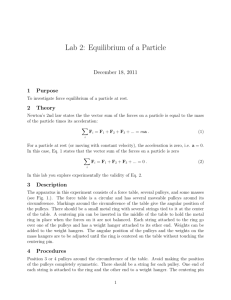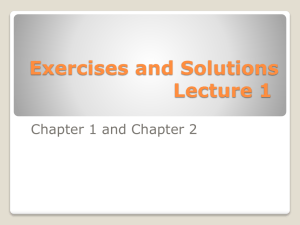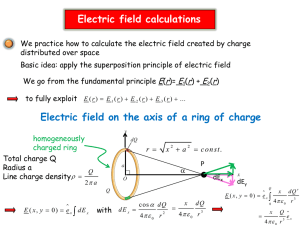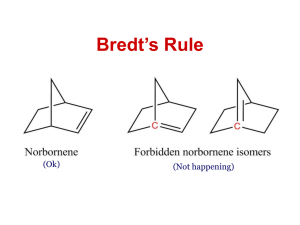Experiment 2 The Addition of Vectors In this experiment a force table
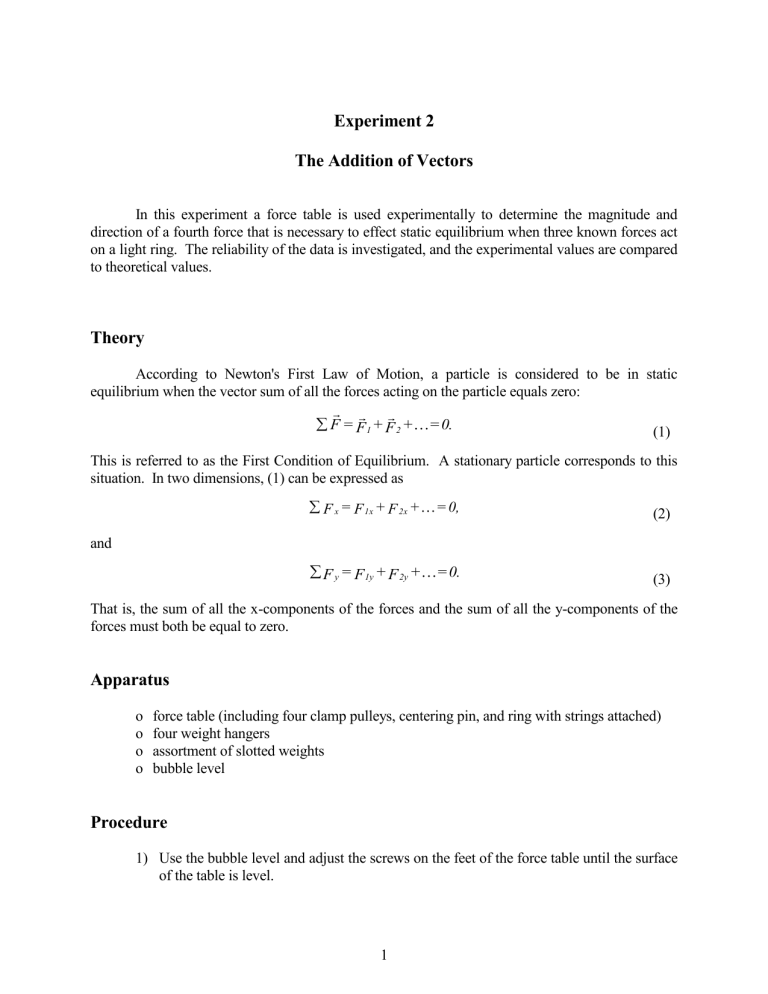
Experiment 2
The Addition of Vectors
In this experiment a force table is used experimentally to determine the magnitude and direction of a fourth force that is necessary to effect static equilibrium when three known forces act on a light ring. The reliability of the data is investigated, and the experimental values are compared to theoretical values.
Theory
According to Newton's First Law of Motion, a particle is considered to be in static equilibrium when the vector sum of all the forces acting on the particle equals zero:
F =
F
1
+
F
2
+ = 0.
(1)
This is referred to as the First Condition of Equilibrium. A stationary particle corresponds to this situation. In two dimensions, (1) can be expressed as
F x
= F
1x
+ F
2x
+ = 0,
(2) and
F y
= F
1y
+ F
2y
+ = 0.
(3)
That is, the sum of all the x-components of the forces and the sum of all the y-components of the forces must both be equal to zero.
Apparatus
o force table (including four clamp pulleys, centering pin, and ring with strings attached) o four weight hangers o assortment of slotted weights o bubble level
Procedure
1) Use the bubble level and adjust the screws on the feet of the force table until the surface of the table is level.
1
2) Place three pulleys at their appropriate angular positions according to Table 1.
3) Place the ring over the centering pin and pass three strings over the pulleys. From the strings, hang the amount of mass corresponding to your group number in Table 1. Do not permit the masses to swing. The line of each string should pass through the center of the ring.
Table 1. Masses and corresponding angles that will be used by each group. The value of the mass represents the total mass (includes the weight hanger).
String 1 String 2 String 3 group number m
2
(g) m
3
(g)
9
10
11
12
7
8
5
6
3
4
1
2 m
1
(g)
1 1(deg)
150
150
200
200
150
150
200
200
150
150
200
200
45
45
45
45
60
60
60
60
30
30
30
30
200
250
150
250
200
250
150
250
200
150
150
200
2 2(deg)
110
150
135
120
150
110
150
150
135
140
110
135
140
100
250
140
180
180
250
170
250
200
200
150
3 3(deg)
200
250
200
200
200
250
200
250
200
250
210
200
4) Determine the angular position of the fourth force that will achieve equilibrium by carefully pulling and varying the angular position of the fourth string until the ring is centered on the pin. Clamp the fourth pulley at this angular position, pass the string over the pulley, and attach the fourth weight hanger.
5) Determine the mass that will achieve equilibrium by adding mass to the fourth weight hanger until the minimum amount necessary to center the ring is found. A method of accomplishing this is to hold the ring so that it is centered around the pin and add mass to the fourth weight hanger that is close to but less than the minimum mass needed to achieve equilibrium. When the ring is released, the ring will move away
2
from the weight hanger. Center the ring again and add small increments of mass until the ring does not move. Record this value as m
4min
. Carefully continue to add mass until the maximum amount is found that will maintain the ring in its centered position. Record this value as m
4max
.
The best value of m
4
is the average: m
4
=
1
2
( m
4 min
+ m
4 max
).
(4)
6) Use (4) to compute m
4
and place this amount of mass on the fourth string. Check that the ring is centered.
7) Loosen the fourth clamp pulley and carefully move the clamp in a clockwise direction until the minimum angle is found that will maintain the ring in its centered position.
Record this value as value as
4 max 5.
4 min 4. Repeat in the counterclockwise direction and record this
Analysis
The uncertainty in m
4
, the average of
4 6, and the uncertainty in
4 7 are given by the following:
m
4
=
1
2
( m
4 max
m
4 min
),
4
=
1
2
(
4 max
+
4 min
),
(5) and
(6)
4
=
1
2
(
4 max
-
4 min
).
(7)
Using (4), (5), (6), and (7), determine for m
4
and one for
4 m
4
10, graph and label
,
m
4
,
4
4
+ _
,
4
8 and
11 and
4 m
4
9. On one-dimensional graphs, one
+ _
m
4 12 using points and error bars. Displace these values vertically from the axes so that the values are clearly visible.
Write the equilibrium equations, (2) and (3), in terms of variables that will allow a theoretical determination of m
4
and m
4
1
, m
2
, m
3
,
1
,
2
,
14 and
3
4 13. Substitute the numerical values of
15. Solve the equations simultaneously for the values of
16. Show all relevant calculations. m
4
and
On the one-dimensional graphs described above, graph and label the theoretical values of
3
m
4
and
4 17. Displace the points vertically from the experimental values so that the results are clearly visible.
Report the experimental values of m
4
and theoretical values of m
4
and
4 19 in a results table.
4 18, their corresponding uncertainties, and the
Conclusions
Indicate what the major sources of error are, and explain how the experimental values are affected by these sources of error. Explain whether or not the experimental values show the effects of these sources of error.
Questions
1) If the force table is not level and the mass of the ring is negligible, will the values of the fourth mass and the angle that achieve equilibrium be different from the values when the table is level? Explain.
2) If the force table is not level and the mass of the ring is not negligible, will the values of the fourth mass and the angle that achieve equilibrium be different from the values when the table is level? Explain.
3) Do the theoretical values of m
4
and
4 20 depend upon the acceleration due to gravity, g? Explain.
4) Do you expect the parts of the strings hanging over the pulleys to affect the values of m
4
and
4 21? Explain.
4

